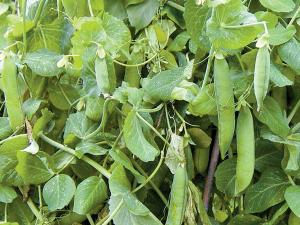The later fall peas are planted, the better
Crazy with the heat. Mom was right. This dry, hot August has many of us panting and breathless in the heat, wondering what to do now that the mercury is climbing.
But why is it that mercury climbing? It is, of course, the mercury-in-glass thermometer, which goes all the way back to its invention in 1714 by German physicist Daniel Gabriel Fahrenheit. Yes, that Fahrenheit. Once he had a thermometer, he had something to measure.
Mercury or not, hot, dry days can cause August tomatoes to crack. Water tomato plants deeply so the roots never dry out. Mulch to keep the root zone cooler. Cracking can also be a sign of calcium deficiency, so give your tomatoes a calcium tea. Soak eggshells overnight or longer in water. Water tomato plants with this eggshell tea and you deliver an immediate boost of calcium to the plant.
If the mercury ever drops, and it finally cools down, plant a fall crop of peas. Because peas are legumes, the roots of peas “fix” nitrogen into the soil. This releases natural fertilizer into the soil, so peas are a good crop to plant before a nitrogen-loving crop like corn (Zea maze).
August has warmer soil temperature, so plant peas for fall nearly twice as deep as you would spring-planted peas. Deep planting helps keep the pea seeds cool and prevents them from drying out before they germinate. Pea seeds germinate best with soil temperatures between 50 to 77 degrees Fahrenheit. Keep the seedbed moist until the peas sprout. They take about six to 14 days to sprout out of the soil.
Always pre-soak your pea and bean seeds for eight to 12 hours in plain water. This allows the peas to germinate faster.
Before planting, coat pea seeds in rhizobia bacteria innoculant. Rhizobia bacteria form nodules on the pea plants’ roots, which capture nitrogen from the air, giving the peas nitrogen fertilizer. The peas provide the bacteria with carbohydrates and minerals. You can buy the pea innoculant from most seed companies or garden supply stores.
Plant plenty of fall peas. Besides the peas themselves, all parts of the pea plant are edible and many gardeners now plant peas specifically for the tender young vines or tendrils. Steam the tendrils lightly and serve with butter.
Because peas grow best in lower temperatures, the later you plant them. the better your chances are for a fall crop. Wando is often touted as being the most heat-resistant pea, though one wonders if it isn’t just crazy with the heat. Regardless, Wando is a nice 24- to 30-inch-tall pea that matures in 70 days.
Many peas, such as Dwarf Grey Sugar snap pea, have beautiful purple flowers. It matures in just 60 days. Daybreak is a fast-maturing pea that is ready to harvest in just 54 days. The small plants are just 20 to 24 inches tall. Daybreak is excellent for freezing.
To maximize space plant double rows of peas along each side of a trellis or fence. You can pick peas right up until frost.
Plant August peas, water and wait while the volume of mercury changes slightly with temperature, and that small change in volume pushes the mercury up the tube. Push, yes, but climb, no. That, Mr. Fahrenheit, would be crazy with the heat.























































